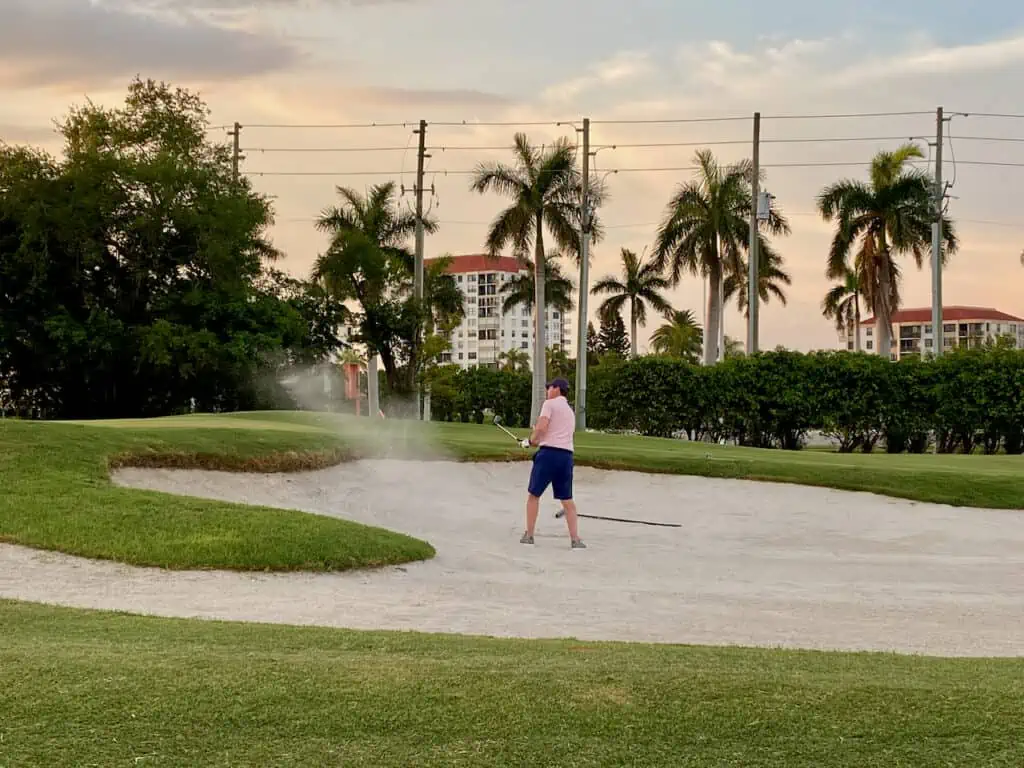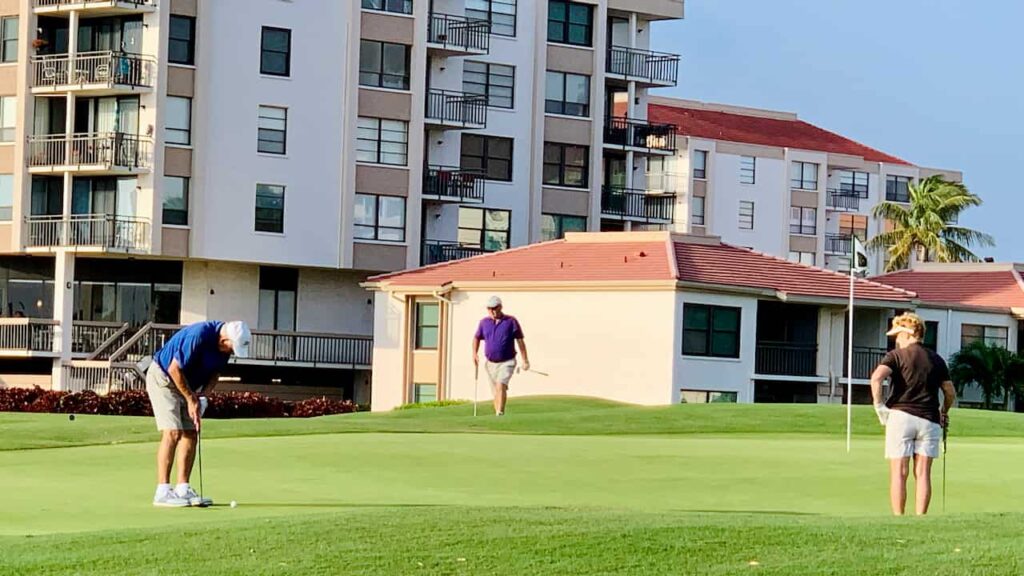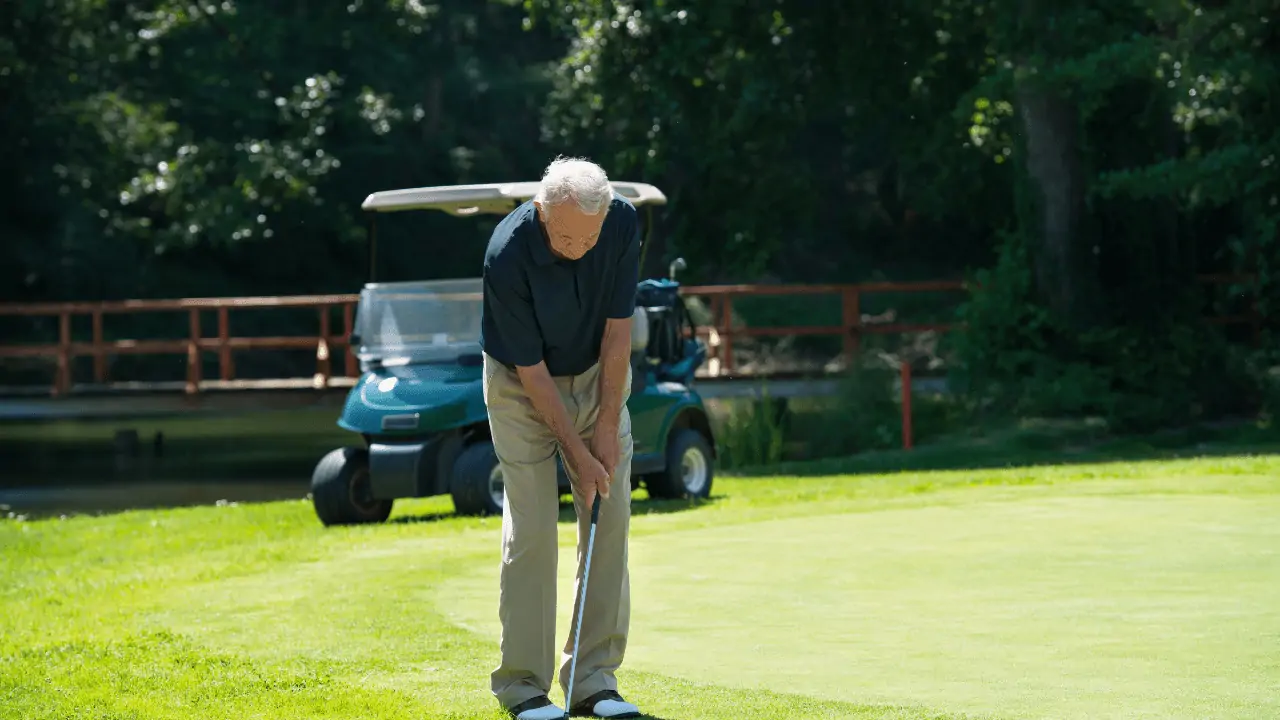Table of Contents
Looking for simple short game tips to quickly improve your score? We have you covered with key tips focused on senior golfers.
Golf gets more challenging as we age. Swing speeds start to slow down, and the ability to recover from a poor lie is only more complicated. However, one area where seniors can actually learn to dominate is in the short game.
These short game tips will give you a better idea of what to focus on when practicing, strategies for short game improvement, and most importantly, specifically geared to the senior golfer.

The 7 Best Short Game Tips
The short game in golf is the most essential part of the game, regardless of your handicap. This is where all of the scoring happens, and if you want to shoot low, your short game must be great.
These top short game tips will help you see what it takes to be a short game expert.
1. Learn More Than One Shot

Not all pitch shots and chip shots are the same. When you watch a professional golfer play, chances are they will have four or five different shots that they hit consistently. Professional players realize that it takes a variety of great shots to get the golf ball in the hole.
As a senior golfer, you should have a few shots with a higher loft and a softer landing and a few shots that are kept more along the ground.
When walking up to the green, you can think about what club to hit, how you will play the shot, and where you want it to land. This is not as simple as grabbing your pitching wedge each time you have to chip.
The more variety you can learn, i.e., flop shot, bump and run, lower lofted shot with spin, higher lofted shot with spin, etc., the better you will be at scoring.
Chip Shot, Flop Shot, Pitch Shot: What’s the Difference?
Senior Golf Source’s professional golf coach, Brett Francisco, demonstrates the difference between these golf shots in a short video that fully explains the key differences.
2. Don’t Be Afraid of Speed
One of the biggest mistakes is slowing down as they approach the golf ball. Instead of accelerating through the golf shot, many seniors slow down and try to help the ball along its way.
This is not effective.
If you want to hit great short game shots with plenty of spin and accuracy, you need to have some clubhead speed.
Don’t forget that even short game shots need a little turn in your body. This helps to increase the speed at which the golf club moves and creates more control. Swinging the club faster does not mean you will hit the ball further; you can adjust the backswing length if needed and use clubs with a little extra loft.
3. Find A Bunker Club You Can Trust
Our third critical short game tip is on bunkers. Many golfers are terrified of them.
We get it, bunker shots are less than ideal, but they don’t have to be feared. The first part of becoming a great bunker player is finding a bunker club that you can trust.
For some golfers, this is a trusty sand wedge. Others will find that the lob wedge increases overall loft and makes it easy to get out of the bunker.
Other golfers purchase a wedge specific to rescuing you out of a bunker. These usually have a wide sole, plenty of bounce, and enough loft to get over any lip in the bunker. The bottom line is that whatever club you hit out of the bunker, you have to be confident in it and choose something with the look and feel you need.
In addition, anytime you can find a practice sand trap, take a moment to throw a few golf balls down and hit some shots. This is an area of the game that players often struggle to practice, and it shows in the results on the course.
⛳️ Read Next: The Best Senior Iron Sets for Men [Expert Review]
4. Keep The Ball Low When Possible
The safest shot around the greens is typically the lowest shot. When you get the golf ball up in the air, other factors are involved, and it could end up causing you higher dispersion rates and higher scores on a hole.
Choose a club like your nine iron or eight iron to keep the golf ball low. Some senior golfers prefer using a chipper as this generally has a lower loft as well.
With these lower shots, you will take a more abbreviated golf swing, try to hit the ball just a few yards, and have it roll the rest of the way. Keeping the ball low means that you have to prepare for some rollout on the shots that you hit.
If you are hitting out of the rough or have a large slope of thick grass to go over, hitting the ball up higher may be your only choice. However, whenever you have the chance to keep the ball low, take it, and you will notice more consistency in your results.
Phil Mickelson Chip Shot Demonstration
Phil Mickelson does an excellent short video on consistently hitting chip shots. He discusses key details that include weight and hands forward that make a huge difference.
5. Help Yourself Out On The Approach Shot
The approach shot to the green should be more than just trying to hit the ball on the putting surface. Having a shot land in an area that makes the next putt makeable and ensure you don’t need to chip again is a tremendous advantage.
When hitting your approach shot, take a look at the entire green. Try to think about not just getting close to the pin but where you might miss it as well.
Let’s say that the pin is just on the green with a bunker in front, but a wide opening in the middle of the green allows you to roll a ball up. In a situation like this, I recommend hitting a shot to the center of the green.
You may have a 15-foot putt, but there is also very little chance you will end up in the bunker. Somewhere around the green is much better than off of it.
If the pin is in a more approachable spot, think about going right at it and getting the ball as close as you can to the pin.
6. Think About The Putt You Are Leaving

In addition to trying to help yourself out on the approach shot, you must also think about the putt that you are leaving yourself. If you hit your approach shot past the pin and it’s straight downhill to the hole, this could be opening the door to a three-putt.
Whether chipping onto the green or lag putting, think about the putt you are leaving yourself.
Find a range of putts that you know you are confident with. For instance, I like a 4-8 foot uphill straight putt. I know my chances of making something like this are considerably higher, and I’ll take advantage of that every chance I get.
⛳️ Read Next: The 13 Best Putters for Seniors To Shave Strokes Today!
7. Short Game Improvement Takes Practice
Hopefully, these tips have helped you realize that the short game is a bit more involved than you may have thought initially. However, one final step here is an unfortunate truth about the short game.
You must hit the ball to get better. Practice is key.
The golfers who play professionally will tell you that the short game is an area of their game that requires a good portion of their time.
When you practice the short game, always work on hitting different types of shots from lies that you may get on the course. In addition, don’t stand and hit the same shot repeatedly; this is not realistic of what will happen on the golf course.
Instead, change things up a bit, work on one type of shot for just one or two swings, and then change the lie or the club so you don’t become too complacent. This will pay off tremendously on the golf course.
Final Thoughts on Short Game Tips
Short game practice should feel fun and inspire the senior golfer. This is the area of your game where you can put in extra effort and actually have it pay off to help you score.
Golfers that are great at the short game can save par and enjoy a less stressful round of golf. This is where your time should be invested.
Frequently Asked Questions
Hopefully, you have some new ideas to go work on your short game. Here are some questions that senior golfers are asking about improving their short game.
How can I improve my short game?
One of the best ways to improve the short game is to purchase at-home short game practice tools.
This can include a chipping net and an indoor putting green. If you can spend 15 to 20 minutes a day working on your short game, it will go a long way.
How do I get better at chipping?
One of the best ways to get better at chipping is to simplify what you do in your chipping stroke.
If you have more of a putting-type stroke with a lofted club, it can work as a chip and help to keep the game more consistent.
What is a short game in golf?
The short golf game is anything less than 50 yards into the hole. These shots require less than a full swing, and it takes time to learn the distance control and precision expected when hitting short game shots like this.

